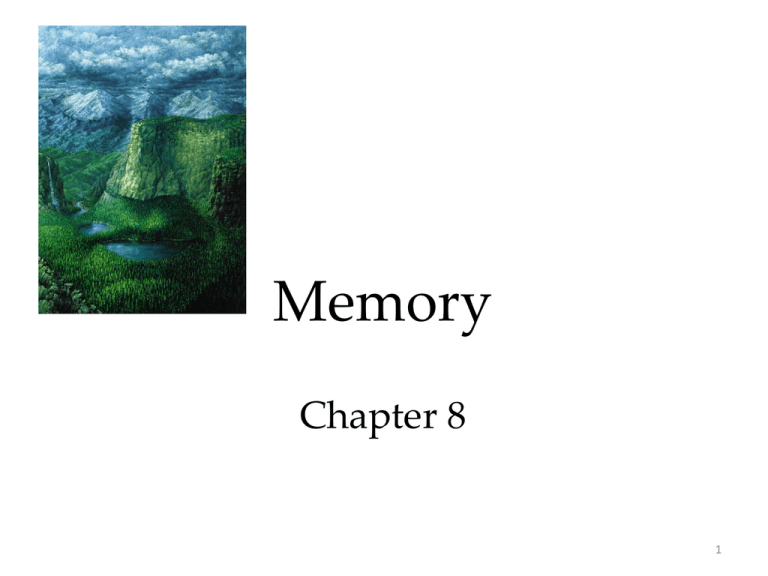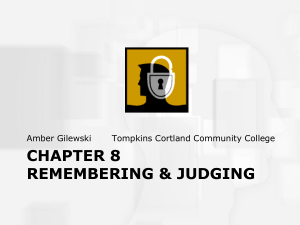
Memory
Chapter 8
1
Memory
Memory is the basis for knowing your friends,
your neighbors, the English language, the
national anthem, and yourself.
If memory was nonexistent, everyone would be
a stranger to you; every language foreign; every
task new; and even you yourself would be a
stranger.
2
The Phenomenon of Memory
Memory is any indication that learning has
persisted over time. It is our ability to store and
retrieve information.
3
Studying Memory:
Information Processing Models
Keyboard
(Encoding)
Disk
(Storage)
Sequential Process
Monitor
(Retrieval)
4
Atkinson-Schiffrin (1968) threestage model of memory
Sensory
Memory
Short-term
Memory
Longterm
Memory
Modifications to the Three-Stage
Model
1. Some information skips the first two stages
and enters long-term memory automatically.
2. Since we cannot focus on all the sensory
information received, we select information
that is important to us and actively process it
into our working memory.
6
Type:
JPG
Sensory and working memory enable people to manage
limited amounts of incoming information during initial
processing
long-term memory serves as a permanent
repository for knowledge.
SENSORY MEMORY
Sensory memory processes incoming sensory
information for ½ to 3 seconds
The main purpose of Sensory Memory is to screen incoming
stimuli and process only those stimuli that are most relevant at
the present time.
Researchers agree that information processing in
sensory memory usually occurs too quickly for people to
consciously control what they attend to
Information that is relevant to the task at hand, and that is
familiar, are the most likely types of information to be
processed in sensory memory and forwarded to the
working memory
Two types of sensory memory:
Iconic - Holds visual memory trace. Duration < 1 sec.
Why not notice eye blinks
Echoic - Holds auditory memory trace. Duration 2 - 4
sec. Last few words echo briefly in head
Working Memory
A newer understanding of short-term memory
that involves conscious, active processing of
incoming auditory and visual-spatial
information, and of information retrieved from
long-term memory
11
WORKING MEMORY
After stimuli enter sensory memory, they are either
forwarded to working memory or deleted from the
system.
Working memory: a multi-component temporary
memory system in which information is assigned
meaning, linked to other information, and essential
mental operations such as inferences are performed.
Effortful Processing
Committing novel information to memory
requires effort just like learning a concept from
a textbook. Such processing leads to durable
and acceptable memories.
Effortful learning usually
requires rehearsal or
conscious repetition.
Ebbinghaus studied
rehearsal by using
nonsense syllables:
TUV YOF GEK XOZ
The more times the
nonsense syllables were
practiced on Day 1,
the fewer repetitions were
required to remember
them on Day 2.
Encoding: Getting Information In
How We Encode
1. Some information (route to your school) is
automatically processed.
2. However, new or unusual information
(friend’s new cell-phone number) requires
attention and effort.
15
Automatic Processing
We process an enormous amount of information
effortlessly, such as the following:
1. Space: While reading a textbook, you
automatically encode the place of a picture
on a page.
2. Time: We unintentionally note the events
that take place in a day.
3. Frequency: You effortlessly keep track of
things that happen to you.
16
Memory Effects
1. Spacing Effect: We retain information
better when we rehearse over time.
2. Serial Position Effect: When your
recall is better for first and last items
on a list, but poor for middle items.
17
What We Encode
1. Encoding by meaning
2. Encoding by images
3. Encoding by organization
18
Encoding Meaning
Processing the meaning of verbal
information by associating it with what
we already know or imagine. Encoding
meaning (semantic encoding) results in
better recognition later than visual or
acoustic encoding.
19
Organizing Information for Encoding
Break down complex information into broad
concepts and further subdivide them into
categories and subcategories.
1. Chunking
2. Hierarchies
20
Sensory Memory
Sensory
Memory
Working
Memory
Long-term
Memory
Encoding
Events
Encoding
Retrieval
Retrieval
21
Sensory memory is the shortest-term element of memory
It is the ability to retain impressions of sensory information
after the original stimuli have ended
It acts as a kind of buffer for stimuli received through the
five senses of sight, hearing, smell, taste and touch,
which are retained accurately, but very briefly
stimuli detected by our senses can be either deliberately
ignored, in which case they disappear almost
instantaneously,
perceived, in which case they enter our
sensory memory
The sensory memory for visual stimuli is sometimes
known as the iconic memory
the memory for auditory stimuli is known as the
echoic memory
that for touch as the hepatic memory
Sensory Memories
The duration of sensory memory varies for the
different senses.
Iconic
0.5 sec. long
Echoic
3-4 sec. long
Hepatic
< 1 sec. long
24
Whole Report
Sperling (1960)
R G T
F M Q
L Z S
“Recall”
RTMZ
(44% recall)
50 ms (1/20 second)
The exposure time for the stimulus is so small
that items cannot be rehearsed.
25
Partial Report
S X T
J R S
P K Y
Low Tone
Medium Tone
High Tone
“Recall”
JRS
(100% recall)
50 ms (1/20 second)
Sperling (1960) argued that sensory memory capacity was larger than
what was originally thought.
26
Working Memory
Working memory, the new name for short-term
memory, has a limited capacity (7±2) and a short
duration (20 seconds).
Sir George Hamilton observed that he could accurately remember up
to 7 beans thrown on the floor. If there were more beans, he guessed.
27
Long-Term Memory
Essentially unlimited capacity store.
R.J. Erwin/ Photo Researchers
The Clark’s nutcracker can locate 6,000 caches of
buried pine seeds during winter and spring.
28
Synaptic Changes
In Aplysia, Kandel and Schwartz (1982) showed
that serotonin release from neurons increased
after conditioning.
Photo: Scientific American
29
Synaptic Changes
Both Photos: From N. Toni et al., Nature, 402, Nov. 25 1999. Courtesy of Dominique Muller
Long-Term Potentiation
(LTP) refers to synaptic
enhancement after
learning (Lynch, 2002).
An increase in
neurotransmitter release
or receptors on the
receiving neuron
indicates strengthening
of synapses.
30
Stress Hormones & Memory
Heightened emotions (stress-related or
otherwise) make for stronger memories.
Flashbulb memories are clear memories of
emotionally significant moments or events
Scott Barbour/ Getty Images
31
Implicit vs. Explicit Memory
Certain forms of memory do not require conscious
executive control
These forms of memory—called implicit
memory
tasks requiring conscious control: explicit
memory tasks.
Storing Implicit & Explicit Memories
Explicit Memory refers to facts and experiences that one
can consciously know and declare. Implicit memory
involves learning an action while the individual does not
know or declare what she knows.
33
Hippocampus
Hippocampus – a neural center in the limbic
system that processes explicit memories.
Weidenfield & Nicolson archives
34
Cerebellum
Cerebellum – a neural center in the hindbrain
that processes implicit memories.
35
Anterograde Amnesia
After losing his hippocampus in surgery, patient
Henry M. (HM) remembered everything before the
operation but cannot make new memories. We call
this anterograde amnesia.
Anterograde
Amnesia
(HM)
Memory Intact
No New Memories
Surgery
36
Implicit Memory
HM is unable to make new memories that are
declarative (explicit), but he can form new
memories that are procedural (implicit).
A
B
C
HM learned the Tower of Hanoi (game) after his surgery. Each time
he plays it, he is unable to remember the fact that he has already
played the game.
37
Tasks requiring implicit
memory
Tasks requiring explicit
memory
mirror tracing
reading reversed text
doing a word-completion
task
singing part of a familiar
song
recalling last year
paired associate learning
identifying the head of
state
writing a term paper
Items in the left column are all indirect forms of
memory. They do not involve a conscious strategy for
retrieving information. If you once learned to read
text that is printed backwards, chances are you will
be able to do it later
Retrieval: Getting Information Out
Retrieval refers to getting information out of the
memory store.
Recall --- retrieving information learned at an earlier
time
3. Which is the correct sequence in the transmission of a neural
impulse?
A) axon dendrite cell body synapse
B) dendrite axon cell body synapse
C) synapse axon dendrite cell body
D) axon synapse cell body dendrite
E) dendrite cell body axon synapse
Measures of Memory
In recognition, the person must identify an item
amongst other choices. (A multiple-choice test
requires recognition.)
1. Name the capital of France.
a.
b.
c.
d.
Brussels
Rome
London
Paris
40
Measures of Memory
In recall, the person must retrieve information
using effort. (A fill-in-the blank test requires
recall.)
1. The capital of France is ______.
Priming is the implicit memory effect in which
exposure to a stimulus influences response to
a later stimulus.
Measures of Memory
In relearning, the individual shows how much
time (or effort) is saved when learning material
for the second time.
List
List
Jet
Dagger
Tree
Kite
…
Silk
Frog
Ring
Jet
Dagger
Tree
Kite
…
Silk
Frog
Ring
It took 10 trials
to learn this list
1 day later
It took 5 trials
to learn the list
42
Retrieval Cues
Memories are held in storage by a web of
associations. These associations are like anchors
that help retrieve memory.
water
smell
fire
smoke
Fire Truck
heat
hose
truck
red
43
Déjà Vu
Déjà Vu means “I've experienced this before.”
Cues from the current situation may
unconsciously trigger retrieval of an earlier
similar experience.
© The New Yorker Collection, 1990. Leo Cullum from
cartoonbank.com. All Rights Reserved
44
Context Effects
Context-dependent memory refers to improved
recall of specific episodes or information when the
context present at encoding and retrieval are the
same.
Scuba divers recall more words underwater if
they learned the list underwater, while they
recall more words on land if they learned that
list on land
Moods and Memories
We usually recall experiences that are consistent with
our current mood (state-dependent memory).
Emotions, or moods, serve as retrieval cues. Our
memories are mood-congruent.
Forgetting
An inability to retrieve information due to poor
encoding, storage, or retrieval.
Absent-Mindedness
Transience
Blocking
Misattribution
Suggestibility
Bias
Persistence
47
Encoding Failure
We cannot remember what we do not
encode.
48
Interference
Learning some new information may disrupt
retrieval of other information.
49
Retroactive Interference
occurs when previously learned information is lost
because it is mixed up with new and somewhat
similar information
Proactive interference
occurs when current information is lost because it
is mixed up with previously learned, similar
information
Positive Transfer--
Works the opposite of interference. Old
information facilitates new learning
Repression---Motivated Forgetting
A basic defense mechanism, that banishes anxiety
arousing thoughts, feelings and memories from
consciousness
Sigmund Freud
Memory Construction
While tapping our memories, we filter or fill in
missing pieces of information to make our
recall more coherent.
Misinformation Effect: Incorporating
misleading information into one's memory of
an event.
52
Misinformation and Imagination Effects
Eyewitnesses reconstruct their memories when
questioned about the event.
Depiction of the actual accident.
53
Misinformation
Group A: How fast were the cars going
when they hit each other?
Group B: How fast were the cars going
when they smashed into each
other?
54
Memory Construction
A week later they were asked: Was there any
broken glass? Group B (smashed into) reported
more broken glass than Group A (hit).
Broken Glass? (%)
50
40
32
30
20
14
10
0
Group A (hit)
Group B (Smashed into)
Verb
55
Source Amnesia
Source Amnesia: Attributing an event to the wrong
source that we experienced, heard, read, or imagined
(misattribution).
Constructed Memories
research shows that if false memories (lost at the
mall or drowned in a lake) are implanted in
individuals, they construct (fabricate) their
memories.
56
Improving Memory
1.
2.
Study repeatedly to boost long-term recall.
Spend more time rehearsing or actively thinking
about the material.
3. Make material personally meaningful.
4. Use mnemonic devices:
associate with peg words — something already
stored
make up a story
chunk — acronyms
57









